Augspurger Quattro 415-Sub418-ET703-SXE3/3500 Ultimate – Nominated for the 2026 TEC Awards

We proud to share that the Augspurger Quattro 415 monitoring system, paired with the Sub418-ET703a subwoofers and powered by the SXE3D Ultimate Extreme amplification platform, has been nominated for a 2026 TEC Award in the Studio Monitors category
This nomination reflects what Augspurger has always stood for: unmatched headroom, precision engineering, and translation accuracy trusted by the world’s top producers and engineers. Augspurger Monitors – Quattro 415-Sub418-ET703-SXE3/3500 Ultimate
Why the Quattro 415 Stands Out
The Quattro 415 is Augspurger’s most powerful main monitoring system, designed for large control rooms and environments where scale and fidelity must coexist.

- Four 18-inch woofers per side deliver staggering low-frequency power and control.
- A rock maple horn with a high-output compression driver featuring a 99.9% Beryllium diaphragm ensures unparalleled mid/high precision, speed, and clarity.
- An integrated ET703A (super high frequency compression driver) extends response into the highest frequencies, powered through the HF crossover for effortless air and detail.
- Frequency response is 18hz - 45,000 kHz +/-1db with less then .003% THD and 134db SPL
- Sub418-ET703 subwoofers, each loaded with dual 18-inch drivers, provide deep, accurate low-end down to 20 Hz.
Together, this combination sets the gold standard for modern studio main monitors.
Amplification & Power
In the Ultimate Extreme configuration, the Quattro 415 system is powered by four SXE3D DSP amplifiers, delivering approximately 18,000 watts of total system power.
- Sub418 cabinets (4 total): 2,500 W each → 10,000 W dedicated low-end headroom
- Quattro 415 mains: 2,000 W per cabinet
- Horns / ET703A supertweeters: 250 W each (crossover-split for HF and supertweeter)
- Per-channel power distribution: 2,500 W (LF/Sub), 1,000 W (MF), 250 W (HF)
This precise distribution ensures maximum headroom while preserving clarity and accuracy at every frequency.
Recognition at the TEC Awards
The Technical Excellence & Creativity (TEC) Awards, presented annually by NAMM, recognize outstanding achievements in pro audio.

The nomination of the Quattro 415 system highlights Augspurger’s ongoing role as a reference standard in professional monitoring.
It acknowledges not just the power of the system, but the engineering precision that allows music created on Augspurger monitors to translate seamlessly to the world.
A Real-World Example: Fernando Garibay’s Master Room
A striking example of the Quattro 415 in action is at the Garibay Center, built for Grammy-winning producer PROF. FERNANDO GARIBAY

- In his master room, designed by Pilchner Schoustal, a custom white installation of Quattro 415 mains with Sub418-ET703s provides unmatched clarity, authority, and inspiration.
- The system allows Garibay to work with confidence, knowing that his mixes and productions will translate to any environment—be it streaming platforms, clubs, or live stages.
This installation demonstrates how Augspurger systems are creative instruments as much as they are monitoring tools.
Looking Ahead
The TEC Award nomination of the Quattro 415 – Sub418 – SXE3D Ultimate Extreme system reaffirms Augspurger’s mission: to design monitors that give artists and engineers the confidence to create without limits.
For more than 40 years, Augspurger has been dedicated to precision, craftsmanship, and innovation. This recognition is a milestone in that journey, and a celebration of the artists and studios who trust us with their sound.
Trusted Worldwide
From Los Angeles to Berlin, Tokyo to New York, Augspurger systems are installed in studios of every scale. Each installation is customized and tuned to its acoustic space, ensuring consistent, uncompromising performance.
Whether in a major commercial facility or a private creative hub, the Quattro 415 system provides the scale, accuracy, and headroom required for world-class production.
Voting for the 41st Annual TEC Awards opens December 1, 2025, and runs through January 12, 2026.
During this period, industry professionals and enthusiasts alike will have the opportunity to cast their votes and help decide the winners. We’re honored that Augspurger has been nominated in the Studio Monitors category, and we invite our community to join us in celebrating this recognition — and to show their support once voting opens.
Harmony and Heritage: A Journey Through 50 Years of Hip Hop at The Hip Hop Museum with Augspurger® Monitors
The Hip Hop Museum’s Reggie Peters (Director of Marketing and Visitor Services), Eric Orr, (Artist In Residence & Gift Shop Manager) and Elai Tubo (Sound Curator & Engineer) reflect on 50 years of hip hop from NYC's Quad Studios, explain the concept of The Hip Hop Museum – located at the birthplace of hip hop in the South Bronx – the birth and growing mainstream popularity of the genre, the evolution of studio technology, why hip hop is a reflection of the human experience and how Augspurger® Monitors have shaped hip hop as we know it.
Brand statements
Launched in 2012, Augspurger® monitors use the latest technological advances in acoustic design and software to provide recording facilities with the most sonically accurate speakers possible . With astounding craftsmanship and high-quality components, coupled with incredible power and precision, Augspurger® monitors have shaped the signature sound of iconic recording facilities worldwide, counting Snoop Dogg, Dr Dre and Alicia Keys among its fans.
Augspurger of Hanover, MA is not affiliated with George Augspurger
Pro Audio Design’s David Malekpour Looks to Translate Pro Studio Success into the Hi-Fi Market

As a 36 year veteran of the professional music industry, founder and president of Professional Audio Design, Inc. David Malekpour has come a long way.
"I started working in pro audio for an acoustic designer and studio tech in 1986, then started my original venture, Anything Special, in 1989," he texts. "I renamed and focused in on pro in January 1993 as Professional Audio Design."
Since then, he's produced a plethora of custom studio recording studios for clients that include Snoop Dogg, Jay-Z, Alicia Keys, Wu Tang and other recording megastars. Based out of Hanover, Massachusetts, he runs a portfolio of five interrelated companies to service a gamut of the pro and home hi-fi markets with great fidelity.
I met David this past April at AXPONA (Audio Expo North America), which was held in the Renaissance Schaumburg Hotel and Convention Center in Schaumburg, IL. Reporting for Positive Feedback, I made the following observations of his room:
The Augspurger® SXE 3D 3-way DSP Networked amplifier ($4995) is driving the Augspurger® MX65 Monitors ($10,995) and the Augspurger® Sub 212 ($4250): 2000 watts feed into the sub channel, 600 to 800 watts in the mid channel, and 400 watts into the high horns.
As such, they are rich, full bodied and image surprisingly large. You can hear the grain in Leonard Kohen's sonorous bass vocals singing "Thousand Kisses," for example, which envelop the entire hotel room.
A Candid Observation and Uncut Interview
It's nearly four months later after that original listening session, and during our respective work commutes, I call Dave to advise him that I finally got around to transcribing our lengthy AXPONA interview and its release is eminent, but I need clarification on a few points and photos from his customized studio projects. During our conversation, he observes that in pro audio, people employ the least components necessary to get the job done while audiophiles have a tendency to go way over the top. "In pro audio, you use the minimum tools necessary to achieve a recording with great fidelity," he says, adding that a carpenter uses a saw to cut wood, but with audiophiles, there's a tendency to introduce way more into the chain than necessary to achieve accuracy as they seek to sweeten it to their tastes.
"They may use cables or tubes to sweeten the sound, whereas we may employ graphic equalizers in the studio," he says.
He recalls that one display room at AXPONA showcased a million dollars of equipment and amplification supplying signal to massive speakers with nine drivers each that filled the room with sound, but for all the flourish and bling, wasn't all that impressive.
What follows is a rare and uncut glimpse into the Pro Audio Design world of Dave Malepour.

DAVID MALEKPOUR I started out originally as a musician, and became a recording engineer in my 20s. And working in a studio, I met a guy who came to fix the studio, and it turned out that he had designed it, and he was an acoustician, and by the end of the night, he'd offered me a job selling the services of his company. It was a real turn on for me because I got to start seeing how studios were created from the inside out, as opposed from a planning, architectural and acoustical viewpoint. That was about 1985.
I worked for him for a few years and decided to start my own business in March of 1989. And combining what I learned from him in design, but also integrating the equipment because, for me, a holistic picture was equipment and the room—not just the room, not just the equipment, but a combination of those two things. So we started off by helping people design their studios, equip them, and it really led me down this great path.
Dynau-mite!
And in 1993, I found this speaker called Dynaudio. They had a pro version called Dynaudio Acoustics, and I was at Happy Roads New Years in London, and I was like, "wow, this thing sounds really incredible," and it led me on this journey. I ended up being their first distributor in the world in 1993. I brought it to the U.S. and we brought it to studios, and started learning how to tune speakers because they had some really big speakers that used adjustable crossovers. EQ them and we could tune the room, and it was like, "Oh," now we could make it a reference point that we could repeat room to room, to room.

An Augsp-icious Start
Along the way, a customer asked me to build him a pair of Augspurger® monitors, which was something you could get a design for that you have to build it yourself like a DIY thing. And he said, "Dave, with your ears and the way you tune speakers, if you had this, this might be a great business for you. But I want to get a pair of them, but there's no companies; you'll have to make them yourself."
So, I went out and I built that first pair of Augspurgers®. I guess it was 97 or 98, and that led suddenly to the next studio wanted them, and the next studio wanted them. And Jay-Z put them in 98 or so, and things started to really blow up with that monitor, and next thing you know, I had 35 pairs of big Augspurger® monitors in the top studios of New York. And I realized then that it was no longer a side project and this had to become something more important to me.
We still were making them one here, one there, and by 2010, the Augspurger® brand became something really important to our business, and we launched it as its own company. We created our own amplifier and we had our own drivers made for us.
A TAD Special
When I first started making them, I had TAD components, which is a tie-in to our client life because we became the number one user of TAD drivers in America for our speakers, and flash forward to last year, TAD came to us and said, "Hey, would you take over the distribution of our pro products?" And that was a no-brainer.
On top of it, they said, "Well, we really want hi-fi to live with pro. Could you take on the hi-fi line?" And so that's sort of how we made the decision to delve into hi-fi with this great legacy brand, TAD, that is incredible.
And then after a couple hi-fi shows, I realized Augspurger®, the speakers that we're making, were also an interesting product that would also do well. It's a different flavor. You know, you walk around a hotel with 150 rooms, 150 different speakers, you realize that there's a place for everybody. So, we felt like a horn loaded, DSP controlled speaker could be interesting.
Holistically Passionate
From the starting point back in the late 80s to 90s, I've had this philosophy of looking at the whole thing, like what makes a great sounding room. The acoustics make a great sounding room, the speaker choices, the positioning—every little thing that goes into it. And because I'm a very passionate person, I think that appealed to artists, and producers, and people who are equally passionate about their music. And so that gave us a really special in in the studio world. And today we have over a thousand studios with Augspurger® monitors worldwide, and it seems to be growing because right now in the first quarter of the year, we had more than half of last year in orders in just the first quarter, so that's like a lot of rhythmic growth for us.

Strength in Diversity
So we have a number of different business units. We have professional audio design. That's our main core of fundamental business—and that's equipment, installation, and we take a design approach to the systems. From there, we ended up starting Malekpour Design Partners. That's my acoustics and architectural acoustics design company.
So we're designing whole, complete studios, and then broad design equips them with either Augspurger® monitors or whatever the client wants. We're dealers for hundreds of brands, but our approach is still the same, which is, it's a systematic approach. So sometimes people still pause and just buy a piece of equipment off a website or whatever, and in our highest position, we do that sometimes in our projects, and that's what we're focused on. (You can view a portfolio page of their studios HERE)
And I've also branched out into distribution of certain projects—JOKAVI acoustic panels, the TAD brand and Sontronics Microphones—you know, we just found really cool stuff that we love and wanted to be associated with and we wanted to bring to market. We have our hands in a lot of different areas. In fact, we have five separate business units total, but they work together. I like to think of us as modular companies, so someone might find us because of Malekpour Design Partners, or they may find us because of Pro Active Design, now today they may find us because of Pad HiFi Design, and with Pad Hi-Fi, our goal is to bring a lot of our knowledge from pro into the hi-fi world (view their site HERE).
You know, for example, today I just gave a panel for acoustics for a listening room either from the ground up, or correcting–there are so many people that need that help. And so Pad Hifi is going to focus on the distribution of TAD products, Auspurger Hi-Fi products, and the JOCAVI acoustic products focused at the hi-fi user.
JA Joe Cobbie?
DM JOCAVI is a Portuguese company. They make acoustic panels but they also have a predictive acoustics model basis, so let's say you have your room, and it's 12 feet by 16 feet with an eight foot ceiling, we could take those dimensions and with a predictive model and know what the room's going to do—the acoustic signature of the room—and we can then with all the products that they make, we have all those coefficients and can then place them into the room in the right way.
Making Beautiful Music with Aesthetics
And of course, there's an aesthetic component to that as well. We can pick woods, and colors and fabrics. Aesthetics are really important. It's how you get your vibe, feeling cool and relaxed—you know, for most people a listening room is a place where most people want to spend a lot of time. Not all of us have enough time. Maybe we work all day, we get an hour or two to listen to something and cool out, so you really want to be comfortable. And so, yeah, we're focused on that whole picture. Like what's the room going to sound like, and then choosing the right components is really important, as well.
Musical Yute
It's kind of where I come from and it all started from a passion for music and you know I've been a musician since I was five years old
JA What?
DM I'm a guitar player and a songwriter. I play a lot of other instruments to some degree—and usually just enough to write songs but the only thing I would perform on is guitar—and sing. In fact, I spent years of my life performing three to four nights a week even up to eight years ago.
Pick Two
I was on the road a lot and my wife said to me, "Hey! You've got a complicated business, you've got your family, and you've got this band. You might want to narrow that down to two."
So I kept my family and I kept my business. I had to move on from playing professionally, but it's still a passion. I play for the kids in the kitchen, you know when I get a few minutes. That's how I unwind. So if you can play golf, I'll play my guitar for the rest of my life.
I still wake up with songs in my mind and, unfortunately, they go to waste now because I can't turn them into recordings because I don't have the time.

Who You Know
I think you mentioned my history doing a studio for Snoop Dogg or Jay-Z. Today, we're finishing a project for Will I Am. And Puff Daddy—we have three rooms we're working on for him. All these really big mega stars, what happens is once one of them finds you—they're all friends (and)... .
"Well, Dave did my room."
"Oh, I need him to do my room!"
So Puff calls and says, "My friend so and so, London on the Track needs a room." And so we've just sort of gotten into this echelon of current Urban bliss and partly because the Augspurger® sound is so powerful and can produce low frequencies down to 20Hz very accurately, so they can get that really visceral, club kind of feeling but have it be very accurate to mix records.
The Right Sounding Stuff
The last thing in a recording studio you want is that the sound is in the speaker and not in the track, right? So what we're focused on is getting the most accuracy in a recording in line, and that translates now to the living room, so we can take that sound that we're having in the studio and that accuracy, and give the listener in a home environment that same experience that they have in the studio.
And sometimes in a home environment, we want it to be sweetening as opposed to revealing, but in a studio, we want to hear all the warts so we can get them out, right?
Home versus Studio Sound
In a home environment, we're not there to evaluate the recording, we're there to enjoy it. So then we can take that starting point of reference and decide if we want a little more bass, a little more highs, or cut out the mids to really make the room sparkle and shine for every type of music that they're listening to.
A lot of our work today is on predictive modeling of the room, putting the right equipment in there, and getting the experience to be something that can make your hair stand up. It's what we're after, right? We want to feel the music, hear it, have it touch us, and experience it the way the artist intended.
And that's one of the things with TAD that I love is they have this slogan—"The artistic intent intact"—and I think that says a lot because I think their speakers are also the most truth telling hi-fi speaker I've heard. They really translate from my experience in the studio to being what you can hear in your own room. It's an amazing product.
And the difference of Augspurger® and a lot of other products is that it's an active system, so the Augspurger® system has a DSP engine in there. So you don't just buy the speaker, you buy the speaker and it comes with an amplifier that allows us to tune the room using the DSP to share each side with the speakers.
Getting Consistent Curves
And when we're tuning a room, you set up the speakers with measurement equipment, and I'll run those measurements, and then I can adjust the system and really get it into shape in almost any way, so I can get the same exact curve in each room, which is really powerful. And especially because a lot of the people I work for are mix engineers that are mixing some of the greatest records of our time (you can view a video on this process HERE)
A lot of our clients are like, 'This guy has 50 number ones,' 'This guy's got 70 number ones! 'Ah, this guy's got 35 Grammys!' So, you know a guy like Rafa Sardina, who's got thirty-something Grammys, coming from World Music to jazz, to symphonic to hip-hop—you know, you look at his catalog and these are records we all know—he's mixing on our system in a room that we tuned. We have that empirical data.
So when I first started, I put up those measurements that I know are the measurements that are relating to those mix engineers, and that's the starting point that I try to get for our clients in their rooms. Whether they're a studio or a home, I think that's really valuable.
Staying Focused
I think we have a bunch of complicated bunch of different elements and really what we do now is make sure that we remain focused on the target: making great sounding rooms, bringing companies like TAD and Augspurger® to the market, so people can appreciate them. And just continuing our work to develop really great sounding spaces.
I'm plagued with a million ideas. It's my blessing and it's my curse. And fortunately having some success, I'm able to dabble and experiment and find different things that really work for us. And we're just refining; we're trying to become the best version of who we are.
Hiring Smarter
It's an old adage: surround yourself with people who are smarter and more experienced than yourself. I have an incredible team of people—we have 22 people to complete stuff in our different companies, and then a whole range of outside subcontractors and vendor providers that we partner with to provide our customers with a really high level of service.
Serve's Up
I think my biggest thing is always just trying to put myself in my client's shoes, like 'what would I want?' because I'm a music lover and I'm an engineer, and I want them to have the experience that I would want to have.
To me, we're in a time right now where there's the internet, you click the button and you buy, and people buy stuff and they don't even know what it's going to do in their environment. Where we're helping guide people on the right products for what they want to do, helping them create the room that they want to have, and that's my mission; just make things sound better.
When I was young, I told my mom that I wanted to have an impact on music with my guitar and my songs, and I didn't realize the impact that I was going to have on a much greater level to producers, to the listeners, to music appreciators and so forth. That's the mark I'm looking to make. Is really making the listening experience great whether home hi-fi, studio, or nightclub.
Predictably Adventurous
A lot of people don't realize when they walk into a room that everything around them is affecting what they hear, so we're really focused on trying to work on that stuff. You know it's an adventure, and every day is a learning experience and I think that's what I love the most is that everyday I get to learn something, I get to think of something, apply it to a project, see how it comes out and, because we have this great 30 some odd year experience and a great team, we're able to kind of know what the results are going to look like; we use predictive modeling for the acoustics, we do rendering for the visual.
Roc'in the Nation with Studio Level Listening Rooms
Like right now, we're working on ROC Nation Headquarters in New York; we're building three studios for them. We did five listening rooms for the record label. You know, and if you're an artist and you just recorded in their studio and you bring your record to the conference room, and it doesn't sound like it sounded in the studio, they may say, "Hey, keep going back to work!"
So, what we've done is we've provided those listening rooms with studio level acoustics and sound systems, and they have the same exact curve as the mix engineers and the artists have in their studio, so it translates for the listener. And now we're going to build new studios for them.
It's a really exciting project being able to help shape the environment where music is made and then also help shape where it's being listened to on the hi-fi side. So, that's my mission.
By Juan C. Ayllon
Top studios continue to choose Augspurger® Monitors
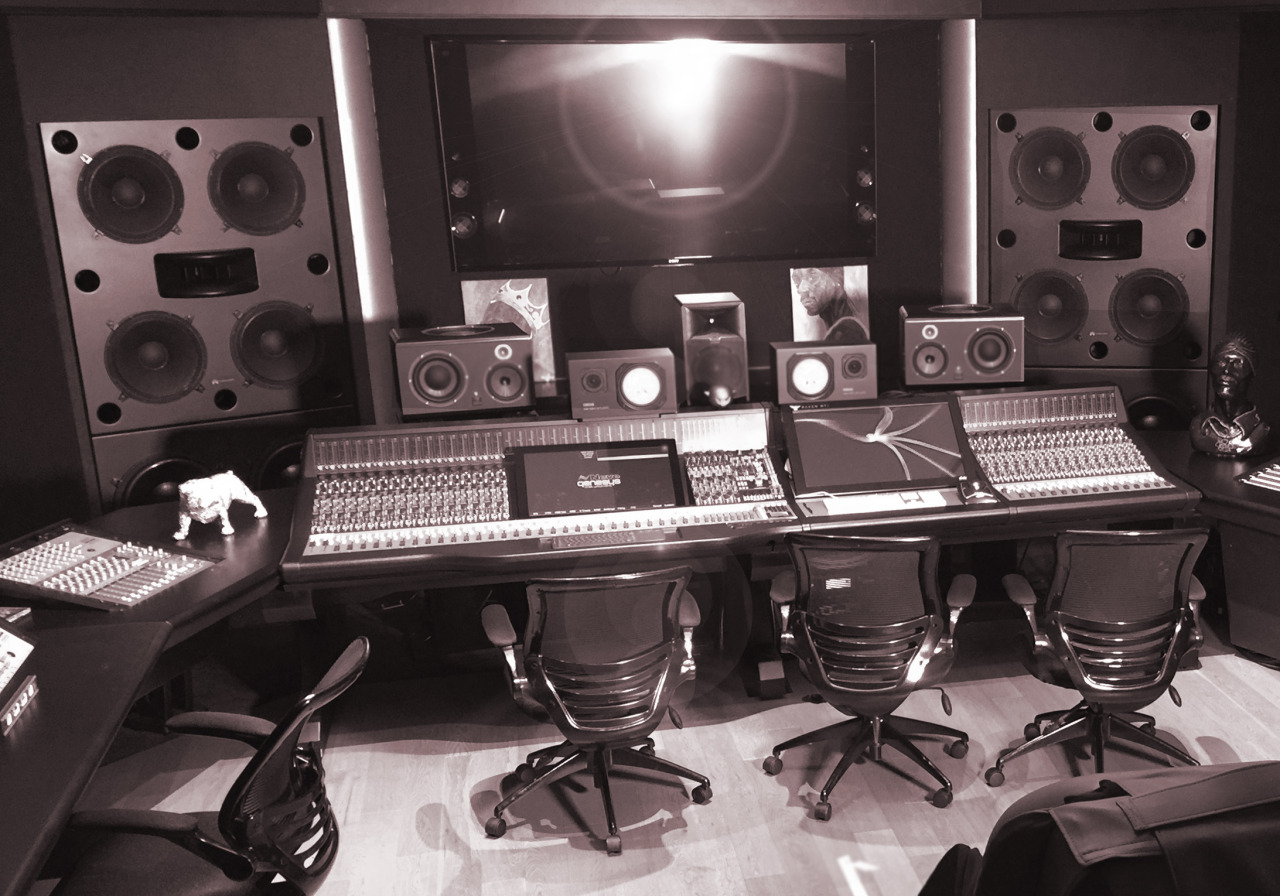
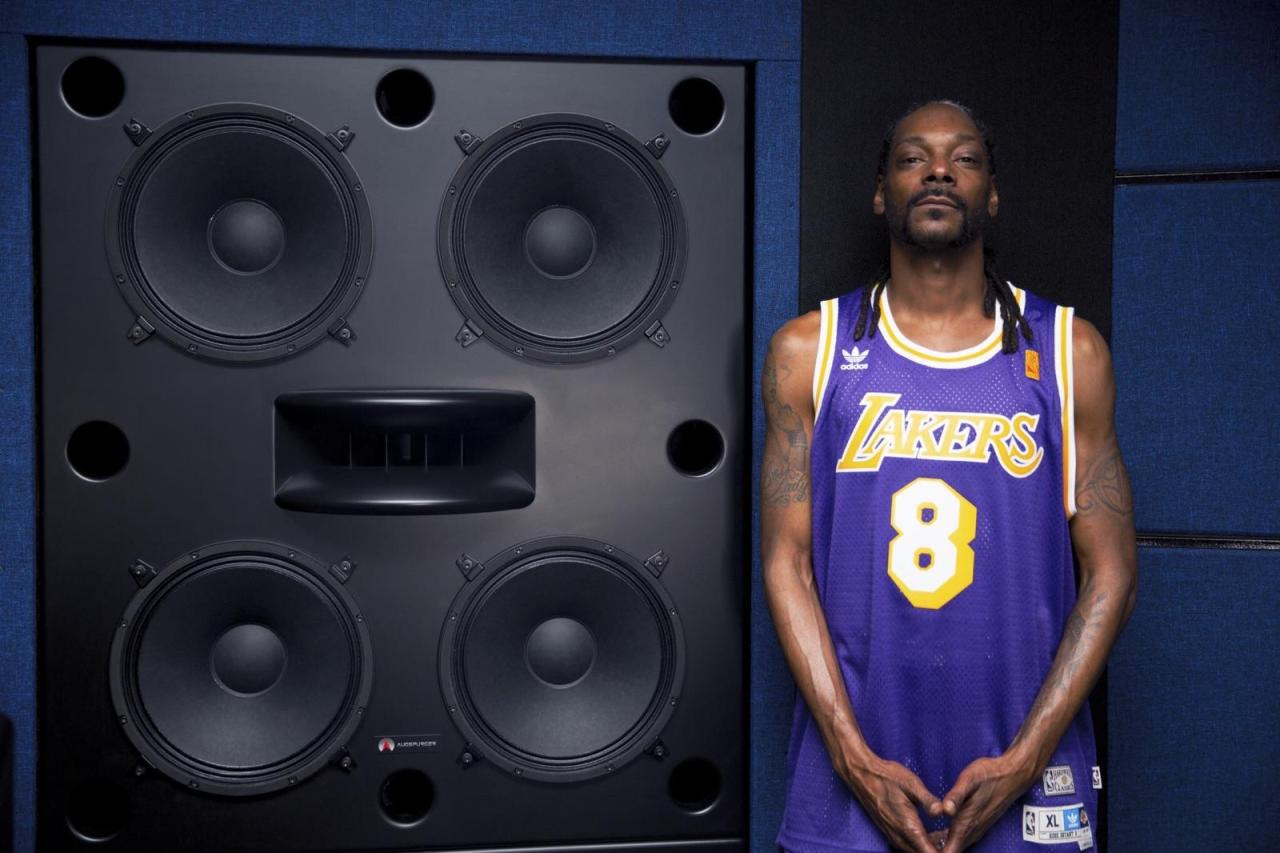 DOGGSpurgers! Snoop and the Augspurger® Quattro 10K system at Beach City.[/caption]
DOGGSpurgers! Snoop and the Augspurger® Quattro 10K system at Beach City.[/caption]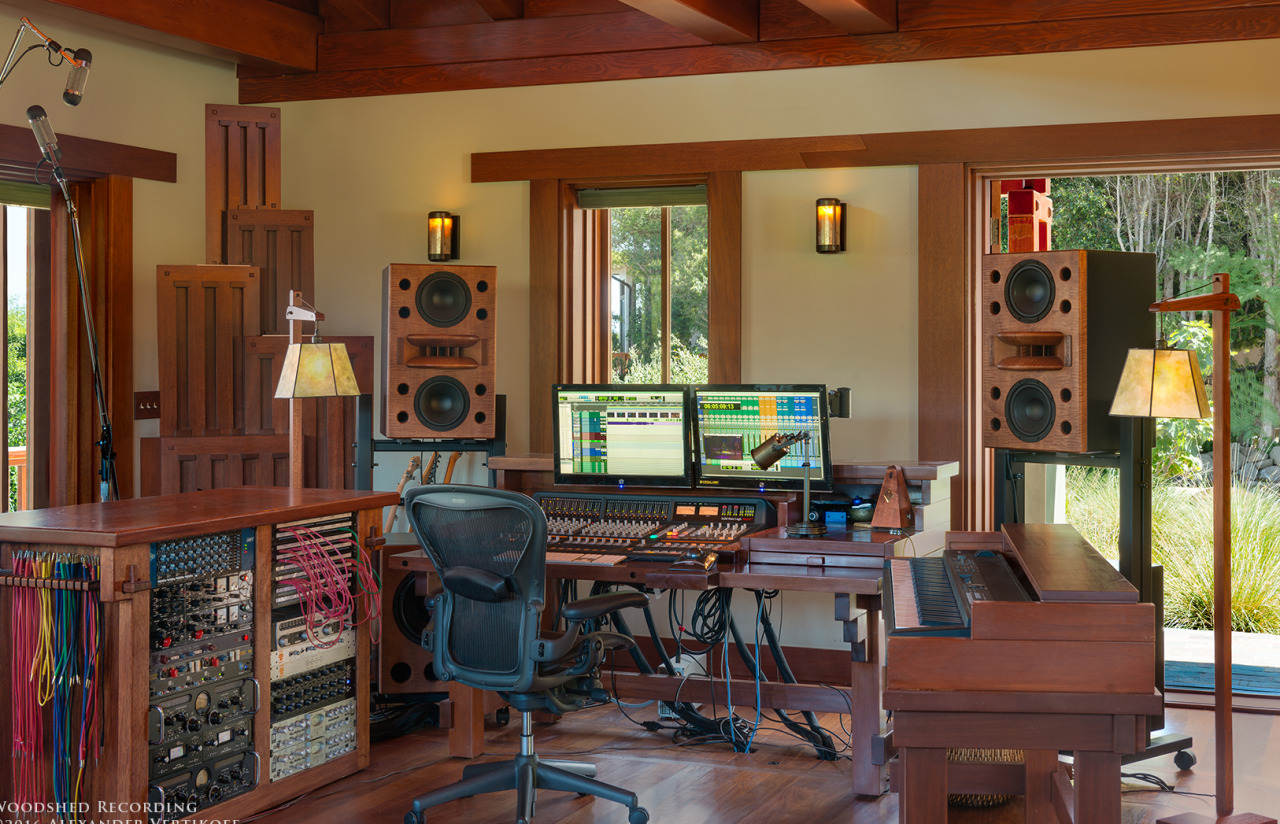 Mali-Beauty! Gibbs Duo 8 with 1X12 subs finished in a hand-rubbed cherry.[/caption]
Mali-Beauty! Gibbs Duo 8 with 1X12 subs finished in a hand-rubbed cherry.[/caption]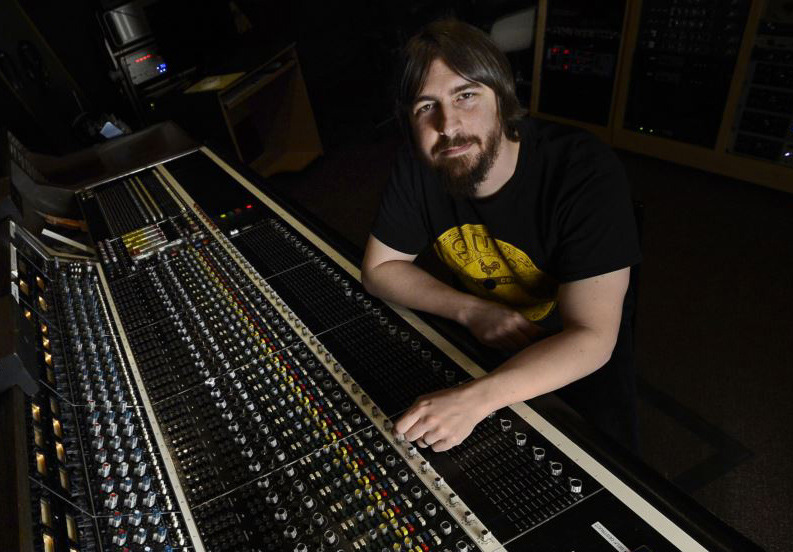 Cobb at the Console: RCA Studio A now rocks Augspurger® Duo 12′s[/caption]
Cobb at the Console: RCA Studio A now rocks Augspurger® Duo 12′s[/caption]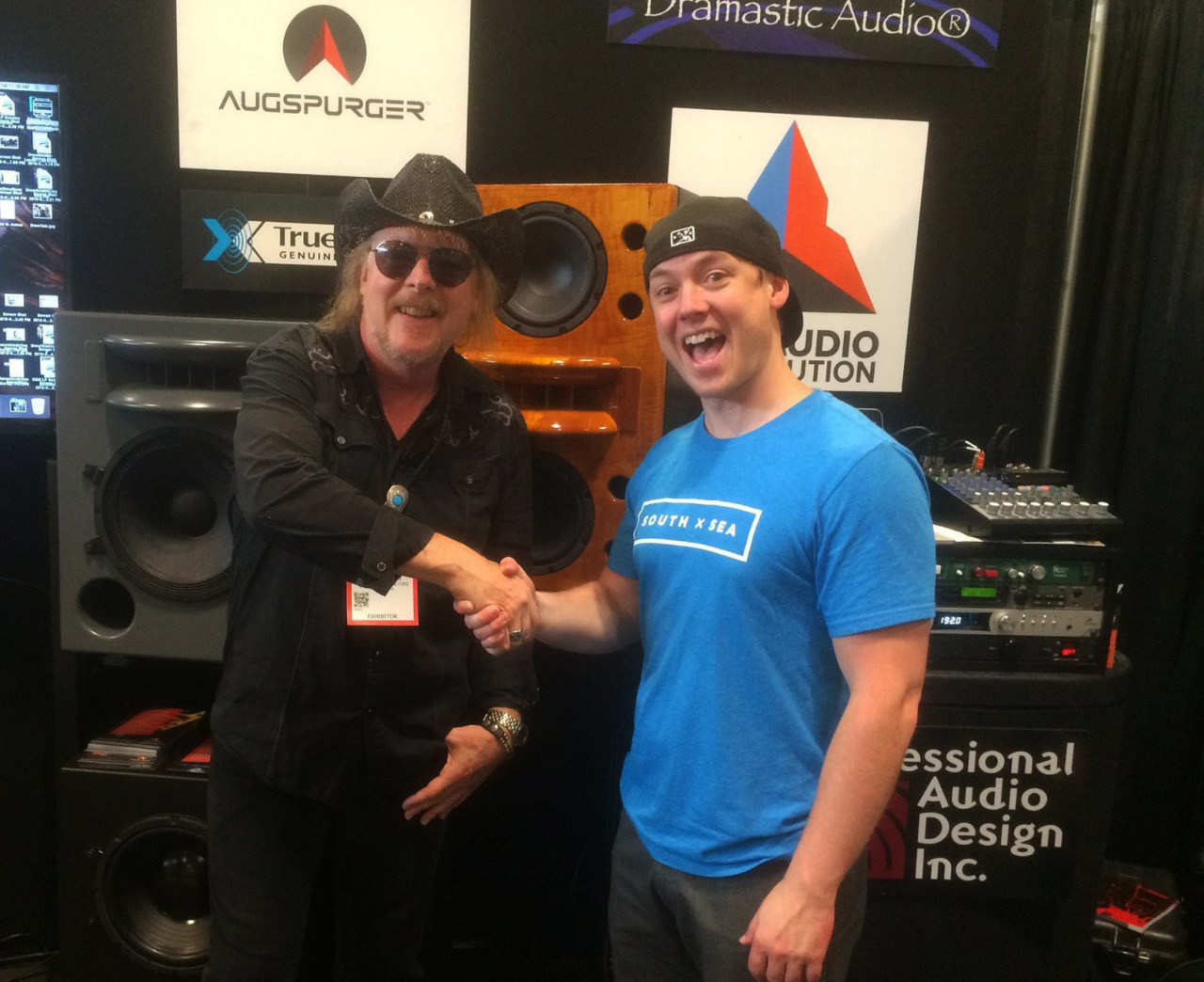 The Music City Sound! Augspurger’s® Drew Townson and Brandon Metcalf of Nashville’s South X Sea at Summer NAMM ‘16.[/caption]
The Music City Sound! Augspurger’s® Drew Townson and Brandon Metcalf of Nashville’s South X Sea at Summer NAMM ‘16.[/caption]